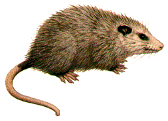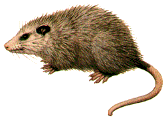



Press any of the buttons below to go to my other pages.
You are currently on a

page.
Disclaimer: these pages reflect my own personal opinions and do not necessarily reflect Department of Conservation policy or opinions


| A tale of two possums | 
|
Directly copied from New Zealand Geographic issue 13 p 50-51
Original author: Warren Judd
New Zealand at that time was just a nondescript bulge on the backside of Gondwanaland, the huge Southern super-continent. As the first marsupials were testing their pouches Gondwanaland was breaking up.
One section of it, the piece which would become Australia, New Zealand and Antarctica, got most of the marsupials, but the large rafts that today we know as the Americas also carried off a fair few, and Latin America still has a rich marsupial fauna.

Perhaps the only American marsupial of which most of us have heard, however, is the opossum, because it is the only marsupial in the United States. There it is a relative newcomer, having moved via Central America in the last 100-000 years. During the last few hundred years it has greatly extended its range from parts of Southern and Eastern USA to all of the States and much of Southern Canada.

Although our possum and theirs share one name (except that Americans like to spell their possum with an "o"), and both are marsupials, they are not close relatives. Nevertheless, comparisons between the two species are interesting, since both are recent successful colonists. Both are furry (except for the American's tail - it's naked), about the same size, nocturnal and adaptable - not many other wild mammals their size have invaded suburbia.
While both species are omnivorous, our local brushtail possum, Trichosurus vulpecula, derives most of its calories from plants. The Virginia opossum, Didelphis virginiana, prefers meat on the whole, but isn't at all fussy - worms, carrion, snails, small snakes, insects, mice, crayfish (they are not averse to getting wet, unlike the Australian brushtail) and most things from inside household rubbish bags. When they have cleared all the food out of an area, they just move on.
[Note from Astrid; since this article was written infra-red video work has shown that the brushtailed possum also eats eggs and chicks, from other evidence we know that possums also eat snails and invertebrates, so they aren't quite as vegetarian as we first thought. I've since also discovered that they are cannibalistic on other possum corpses.]

|
Trichosurus differs considerably here. Young weaners, and especially males, emigrate to new turf, but once they have chosen their patch they usually stay there for life. Females are dominant, and possum society consists of overlapping home ranges, varying in size depending on food availability and population density. There may be 01 to 25 per hectare [possum densities in NZ are much higher than in their home territory of Australia, especially on bush - pasture edges] The area will contain a number of den sites, and animals seem to rotate around them. Two possums my share a den on occasion, but usually they are solitary animals.
Each night, feeding occupies several hours, mainly between dusk and midnight, and to a lesser extent towards dawn, with snacks in between. When food is very scarce they may feed during the day, but generally possums will starve to death in their area rather than move elsewhere.
These simple behaviour patterns probably stem from the particularly small brains possums (and indeed most marsupials) possess relative to their size. Still, these brains enable them to feed and breed adequately, and that's all it takes to be a successful animal.
Breeding is another major difference between Trichosurus and Didelphis. Both have short gestation periods (13 -18 days) and give birth to young which are smaller than a honeybee in size. The female crouches with her tail forward to give birth. She licks a narrow track of fur from the vulva up to the pouch entry (10 cm distance) and the young emerge on to the base of the tail, then clamber up the wet fur path into the pouch.
At birth the young of both species are very poorly developed. Backlegs are rudimentary paddles, and ears and eyes are completely lacking. But what's necessary is there: a nose, mouth and tongue, and strong front legs with claws to make that first essential ascent. Once in the pouch the embryo attaches to a teat and sucks for about 70 days. Thereafter it releases the teat for increasing intervals.

So, how do possums differ in breeding, with all this in common? Mainly in the number of young produced. In New Zealand, the possum produces one embryo at a time (twins are very rare, although the mother has two teats), but the superlative American delivers up to 50 embryos! Usually only 7 - 10 will be weaned (the mother usually has 13 teats) but it is an impressive difference. Of course, it is liked to other distinctions in life history. The major one is longevity. The US opossum is usually dead by the age of two, but well within that time the female will have raised two litters totaling 18 or more young.
Life locally [here in New Zealand] is comparatively leisurely. Most possums breed only once a year, in the autumn, although where conditions are particularly lush they may breed a second time in spring. However, they can live 10 or more years, and many survive for 5 or 6. Since our possum becomes sexually mature at 10 -12 months, on average she'll still produce far fewer young than her American cousin.
Back in the pouch, fur appears on the joey of both species at 100 days, and the eyes open 10 days later. Around 120 or 130 days, young emerge from the pouch for increasing intervals to travel on mother's back. Most have vacated the pouch completely by 200 days.
Thereafter, young gradually become more independent, first following the mother and then living separately within her range. Males usually play no part in raising the joey. However, either sex will willingly carry an orphan on its back.
With this striking reproductive performance, why has the American opossum not become a major pest? Probably it is predators, both human and other, which make the critical difference. In one study, 35 % of tagged animals died in accidents with vehicles. While more than a few perish that way her, too our absence of predators makes life pretty safe for the brushtail possum. In Australia, dingoes, foxes, lace monitors, snakes and owls hold numbers down to such a low level that the species has to be protected by law. [Note NZ trees also have more den sites, it is also safe to nest on the ground, and the food (mainly leaves and fruits) is a lot less toxic to eat. This means that a similar sized area can support many more possums than in their homeland of Australia] >
For the record, there's one other difference between our possum and the American version: ours don't "play dead" (simulate death) when confronted with danger
Recipe plagerised from Hillbilly page
|
One large Possum (or ground beef if you can't find one) |
two 16 oz cans ranch style beans |
|
One can rolte tomatoes with green chiles |
One medium onion chopped |
|
Garlic powder to taste |
salt and pepper to taste |
|
Two 1 pound boxes velveeta Mild mexican cheese |
1/2 cup milk |
|
Corn chips |
|
In a large deep skillet brown possum and onion. Remove the mixtur from the pan and drain it. in the same pot mix the beans, chilies and tomatoes, and cook on medium heat untill mixtur is cooked down a little. Return the possum and onion to pot. In a microwave safe dish combine the cheese cubes and milk, and microwave untill melted. Pour melted cheese in with other ingredients and cook over low heat for about 10 minutes. Stir often. Pour over corn chips.
![]()
Back to the diary index | More about me | More about my PhD | Other adventures
Next page
![]() Get your own Free Home Page
Get your own Free Home Page